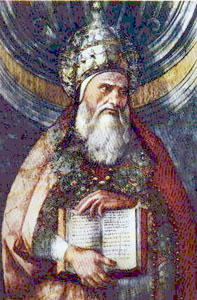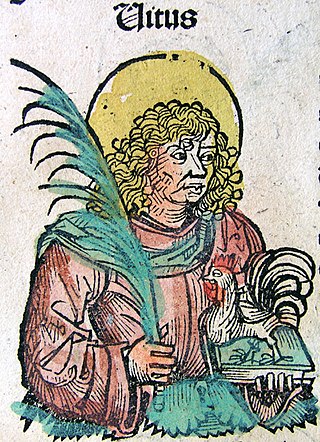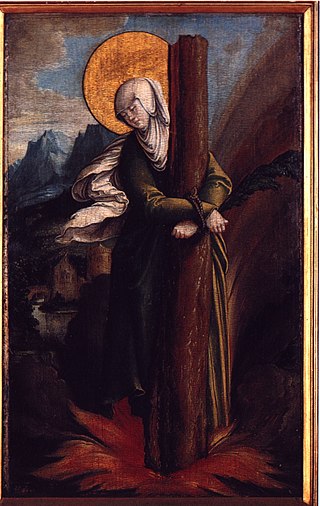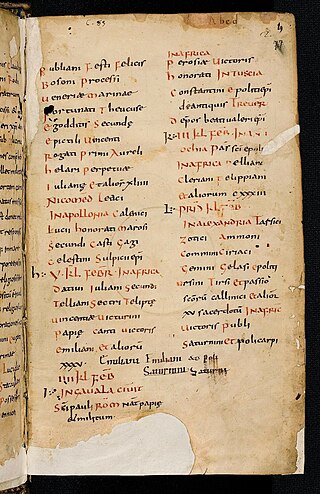Related Research Articles

Pius I was the bishop of Rome from c. 140 to his death c. 154, according to the Annuario Pontificio. His dates are listed as 142 or 146 to 157 or 161, respectively. He is considered to have opposed both the Valentinians and Gnostics during his papacy. He is considered a saint by the Catholic Church with a feast day in 11 July, but it is unclear if he died as a martyr.

Pope Marcellinus was the bishop of Rome from 30 June 296 to his death in 304. A historical accusation was levelled at him by some sources to the effect that he might have renounced Christianity during Emperor Diocletian's persecution of Christians before repenting afterwards, which would explain why he is omitted from lists of martyrs. The accusation is rejected, among others, by Augustine of Hippo. He is today venerated as a saint in the Catholic Church and in the Serbian Orthodox Church.

Vitus, whose name is sometimes rendered Guy or Guido, was a Christian martyr from Sicily. His surviving hagiography is pure legend. The dates of his actual life are unknown. He has for long been tied to the Sicilian martyrs Modestus and Crescentia but in the earliest sources it is clear that these were originally different traditions that later became combined. The figures of Modestus and Crescentia are probably fictitious.

Saint Afra was martyred during the Diocletian persecution. Along with Saint Ulrich & St Simpert, she is a patron saint of Augsburg. Her feast day is August 7. Afra was dedicated to the service of the goddess Venus by her mother, Hilaria. Through his teachings, Bishop Narcissus converted Afra and her family to Christianity. When it was learned that Afra was a Christian, she was brought before Diocletian and ordered to sacrifice to the pagan gods. She refused and was condemned to death by fire.
A martyrology is a catalogue or list of martyrs and other saints and beati arranged in the calendar order of their anniversaries or feasts. Local martyrologies record exclusively the custom of a particular Church. Local lists were enriched by names borrowed from neighbouring churches. Consolidation occurred, by the combination of several local martyrologies, with or without borrowings from literary sources.

Saint Alban is venerated as the first-recorded British Christian martyr, for which reason he is considered to be the British protomartyr. Along with fellow Saints Julius and Aaron, Alban is one of three named martyrs recorded at an early date from Roman Britain. He is traditionally believed to have been beheaded in Verulamium sometime during the 3rd or 4th century, and has been celebrated there since ancient times.

Saint Anastasia is a Christian saint and martyr who died at Sirmium in the Roman province of Pannonia Secunda. In the Eastern Orthodox Church, she is venerated as St. Anastasia the Pharmakolytria, i.e. "Deliverer from Potions". This epithet is also translated as "One who Cures (Wounds)" in Lampe's A Patristic Greek Lexicon.

The Martyrologium Hieronymianum or Martyrologium sancti Hieronymi is an ancient martyrology or list of Christian martyrs in calendar order, one of the most used and influential of the Middle Ages. It is the oldest surviving general or "universal" martyrology, and the precursor of all later Western martyrologies.

According to legend, Rufinus of Assisi, was the first bishop of this city and a martyr.

Martinian and Processus were Christian martyrs of ancient Rome. Neither the years they lived nor the circumstances of their deaths are known. They are currently buried in St. Peter's Basilica in Rome.

Saint Juvenal is venerated as the first Bishop of Narni in Umbria. Historical details regarding Juvenal's life are limited. A biography of Juvenal of little historical value, written after the seventh century, states that Juvenal was born in Africa, was ordained by Pope Damasus I, was the first bishop of Narni, and was buried in the Porta Superiore on the Via Flaminia on August 7, though his feast day was celebrated on May 3. This Vita does not call him a martyr but calls him a confessor. The martyrologies of Florus of Lyon and Ado describe Juvenal as a bishop and confessor rather than as a martyr.
Nicomedes was a martyr of unknown era, whose feast is observed 15 September. He was buried in a catacomb on the Via Nomentana near the gate of that name.

Nereus and Achilleus are two Roman martyr saints. In the present General Roman Calendar, revised in 1969, Nereus and Achilleus (together) are celebrated on 12 May.
There are several saints named Rufus, of which the Roman Martyrology records ten; historical mention is made of the following ones, which have liturgical feasts:
- On 19 April, a group of martyrs in Melitene in Armenia, one of whom bears the name of Rufus. These martyrs are mentioned already in the Martyrologium Hieronymianum.
- On 1 August, Rufus, with several companions who, according to the most reliable manuscripts of the "Martyrologium Hieronymianum" died at Tomi, the place being afterwards by mistake changed to Philadelphia.
- On 27 August, two martyrs named Rufus at Capua -- one, whose name also appears as Rufinus in the "Martyrologium Hieronymianum". The other is said to have suffered with a companion, Carpophorus, in Diocletian's persecution circa 304 AD.
- On 25 September, several martyrs at Damascus, among them one named Rufus.
- On 7 November, a Rufus of Metz, who is said to have been Bishop of Metz; his history, however, is legendary. His name was inserted at a later date in an old manuscript of the "Martyrologium Hieronymianum"(ed. cit., 140). In the ninth century his relics were transferred to Gau-Odernheim in Hesse, Diocese of Mainz.
- On 12 November, Rufus, legend, without any historical proof, the supposed first Bishop of Avignon, who is perhaps identical with Rufus, the disciple of Paul.
- On 21 November, Rufus the disciple of the Apostles, who lived at Rome and to whom Saint Paul sent a greeting, as well as he did also to the mother of Rufus. St. Mark says in his Gospel that Simon of Cyrene was the father of Rufus, and as Mark wrote his Gospel for the Roman Christians, this Rufus is probably the same as the one to whom Paul sent a salutation.
- On 28 November, a Roman martyr Rufus, probably identical with the Rufinianus who was buried in the Catacomb of Generosa on the Via Portuensis, and who is introduced in the legendary Acts of the martyrdom of St. Chrysogonus.
- On 18 December, the holy martyrs Rufus and Zosimus, who were taken to Rome with St. Ignatius of Antioch and were put to death there for their unwavering confession of Christianity during the persecution of Trajan. St. Polycarp speaks of them in his letter to the Philippians.

Petronilla is an early Christian saint. She is venerated as a virgin by the Catholic Church. She died in Rome at the end of the 1st century, or possibly in the 3rd century.
Basilides and Potamiaena were Christian martyrs now venerated as saints. Both died in Alexandria during the persecutions under Septimius Severus.
Basilides, Cyrinus, Nabor and Nazarius are saints of the Catholic Church, mentioned in the Martyrology of Bede and earlier editions of the Roman Martyrology for 12 June as four Roman martyrs who suffered death under Diocletian.

Quirinus of Neuss, sometimes called Quirinus of Rome is venerated as a martyr and saint of the Eastern Orthodox Church and Roman Catholic church.. His cultus was centred at Neuss in Germany, even though he was a Roman martyr.

Agapitus is venerated as a martyr saint, who died on August 18, perhaps in 274, a date that the latest editions of the Roman Martyrology say is uncertain.

Dorothea of Caesarea is a 4th-century virgin martyr who was executed at Caesarea Mazaca. Evidence for her actual historical existence or acta is very sparse. She is called a martyr of the late Diocletianic Persecution, although her death occurred after the resignation of Diocletian himself.
References
- ↑ "Roman Martyrology September, in English".
- ↑ Sampson Erdeswick (1844). Survey of Staffordshire.
- *
 This article incorporates text from a publication now in the public domain : Herbermann, Charles, ed. (1913). "Sts. Rufinus". Catholic Encyclopedia . New York: Robert Appleton Company.
This article incorporates text from a publication now in the public domain : Herbermann, Charles, ed. (1913). "Sts. Rufinus". Catholic Encyclopedia . New York: Robert Appleton Company.